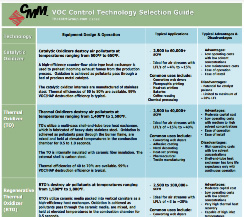Regenerative thermal oxidizers are a necessary yet complex tool needed to reduce the environmental impact of a manufacturer while bringing the company within compliance of state and Federal regulations. Just one of the many oxidizer options available to manufacturers, the RTO is designed and customized to a company’s specific needs, taking into consideration everything from industry-based requirements to the makeup of process exhaust to potential energy recovery and reuse needs.
What is a Regenerative Thermal Oxidizer?
Regenerative Thermal Oxidizers are designed to destroy volatile organic compounds (VOCs), eliminate hazardous air pollutants (HAPs), and neutralize odors present in process exhaust. Operating at temperatures ranging from 815°C (1,500°F) to 980°C (1,800°F), RTOs provide pollutant destruction capabilities at or above industry requirements and thermal energy recovery ranging from 85 to 97 percent.
How Does a Regenerative Thermal Oxidizer Work?
In operation, the process exhaust fumes are pushed or pulled into the Regenerative Thermal Oxidizer inlet manifold using a high-pressure supply fan. From here, the exhaust is directed to an energy recovery chamber, before being directed to a ceramic canister, where the pollutant laden air adsorbs heat.
After passing through the ceramic media, the pollutant-laden air heads to the combustion chamber, where it is held at the necessary temperature for destruction. After oxidation, the hot air is directed through a second energy recovery canister, in which the air is cooled and then routed to the exhaust manifold. Throughout the process, the airflow is switched so that one ceramic chamber heats the air and the other cools it.
Typical Regenerative Thermal Oxidizer Applications
RTOs are designed and built for many industries, and can fit into nearly all manufacturing processes, manufacturers will often choose an RTO to handle pollutants in high-temperature process exhaust. This is due in part to the high temperature needed to destroy VOCs through thermal oxidation alone (and associated costs), and the potential effects that such a piece of equipment may have on lower temperature applications.
In this, while RTOs can fit for a multitude of industries, they are best suited for the following industrial applications:
- Chemical Processing, Coatings, and Paint
- Printing and Packaging
- Fiberglass Reinforced Plastics (FRP) Manufacturing
Regenerative Thermal Oxidizer Design Considerations
As you consider your options for VOC abatement, there are certain factors on which RTOs are designed. Here are some of the things that will affect the way an RTO is manufactured.
The Three T’s
In combustion, there are three critical factors that go into making sure that a VOC is completely destroyed: Time in the chamber, temperature, and turbulence.
Time in Chamber
In order to completely destroy a VOC, the compound needs to stay in the combustion chamber for a specific amount of time, usually 0.5-1 second, with more time needed for complex, hard to burn hydrocarbons like those found in pesticides. This design consideration works in tandem with the other two, as it will dictate fan speed and will be based on the combustion temperature.
Temperature
Temperature is the second element of combustion, and refers to the chamber/furnace temperature (as opposed to stack temperature). Often, the temperature required to destroy a hydrocarbon in a thermal oxidizer ranges from 1,400-1,800 Degrees Fahrenheit. This is a key design consideration, and needs to be discussed as it pertains to the chemicals in process exhaust.
Turbulence
For a VOC to be effectively destroyed, it has to be mixed with the right amount of oxygen in order to balance out the chemical reaction that is combustion. Highly dependent on the emissions contents, oxygen ranges from as little as 2% to over 21% of the volume.
Volume, Concentration, and Types of VOCs Present
VOCs encompass over 10,000 different chemicals, ranging from simple chains to complex carbon ring structures, and including a multitude of additional chemicals that need to be measured and mitigated. This is why all of the RTOs we design are made based on the unique exhaust streams of our clients. In RTO design, we document the unique VOCs created as a byproduct of the manufacturing process, and work with you to create a product that encompasses the right time, temperature, and turbulence.
Additional Considerations in RTO Design
Depending on the temperature of your exhaust and the temperature needed to destroy VOCs, you may need to incorporate a fuel source to power the RTO. We will find for you the most efficient method, and one that will operate as affordably as possible with minimal risk or downtime.
As an RTO is completely customized for your processes and exhaust streams, there are many different parts that go into the design of the RTO:
- Process Exhaust Inlet and Supply Fan
- Heat Exchange/Ceramic Media
- Combustion Components
- Fuel Source/Burner
- Outlet Valve
- Airflow Switching Valves
- Enclosure/External Shell
- Programmable Logic Controllers/Technology
The CMM Group: Custom Designed Pollution Control and VOC Abatement
At The CMM Group, we’ve been in the business of pollution control and VOC abatement for nearly two decades, and know what it takes to document processes, design products, and destroy VOCs. From the simple to the complex, we have worked with organizations of all sizes to design the right VOC abatement product for their needs. Learn more about our work by downloading The CMM Group Guide to VOC Abatement and contact us to learn more.
CONTACT US NOW



